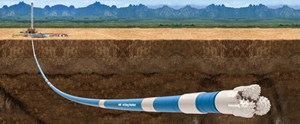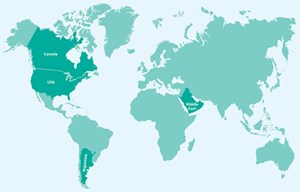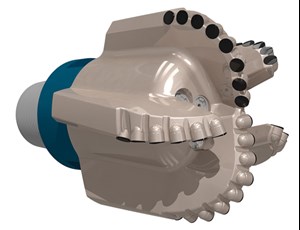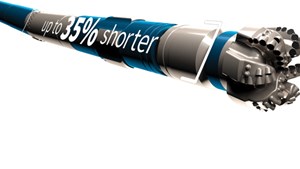
Increasing drilling efficiency and tool reliability are mandatory in the difficult economic environment and competitive marketplace. To meet these requirements, the industry demands new technologies to drive down break-even costs. To improve penetration rates, operators are selecting motor BHAs equipped with more aggressive bits that generate higher torque levels. The increased cutter count intensifies torsional loading on internal connections and bearing assemblies that can lead to premature tool failure.
These reliability issues, when operating in demanding lateral applications, contribute to non-productive time (NPT). In many cases, the longevity of a positive displacement motor (PDM) depends on the strength of the bearing assembly, and operators require more durable components to prevent higher reactive torque from damaging the driveshaft.
OIL-SEALED BEARING PACKAGE
To increase tool reliability, National Oilwell Varco (NOV) has enhanced its oil-sealed bearing technology (ST3E) used in motors applied in the world’s various drilling theaters. Ideal for high-torque lateral applications, these fully sealed bearing assemblies pass 100% of the drilling fluid directly to the bit with no loss via a flow restrictor. This configuration extends bearing life/motor durability and improves hole cleaning by maximizing bit hydraulics.
The bearing assembly is capable of withstanding extreme loads in demanding applications, including oil-based mud systems, casing while drilling, curve/lateral drilling, and when used as a power section in a rotary steerable system. Because the radial and axial bearing elements are completely sealed in oil, the bearing pack is ideal for use when abrasive and corrosive drilling fluids are expected. The bearing’s increased toughness enables operators to fully exploit the higher horsepower available in the industry’s highest-performing power sections.
NEW BAKKEN CHALLENGE
Drilling long lateral sections in the Bakken formation requires the use of PDC bits designed to achieve a rate of penetration (ROP) of 150 ft/hr or faster. However, the aggressive bits have led to NPT issues related to the high-horsepower motors and have increased well costs, negating any improvements realized by faster drilling rates. To improve project economics, engineers wanted to complete the section in a single run and required motors durable enough to survive the increased torque load while drilling at higher ROPs.
The power section of motors used in this application are covered with a high-performance rubber coating designed specifically for long lateral applications. However, the uniform thickness of the rubber coating enables the motor to rapidly build torque, which generates higher operational loading and can result in component damage or failure. Furthermore, high temperatures and elevated RPM put additional strain on the motor’s bearing assembly.
To improve motor durability, the power section was equipped with an enhanced ST3E bearing pack. The improved strength of the bearing pack’s load-carrying components would enable an existing power section to deliver the torque and RPM required to finish a long lateral through harsh formations at high ROP in a single run. The new bearing package, used in conjunction with optimized bit designs and high-torque power sections, has enabled operators to extend distance drilled and increase ROP in the Bakken region.
BAKKEN CASE STUDIES
In Williams County, N.D., an operator used a 5-in. 6/7 lobe, 8.0-stage motor with an even-rubber-thickness technology power section, and enhanced 5⅛-in. ST3E sealed bearing pack, on nine wells. Designed to withstand greater torque and differential pressures than conventional motors, the enhanced PDM completed five one-run laterals and maintained competitive ROPs in seven runs exceeding 8,000 ft, each. On average, the runs are 66% longer than wells drilled with conventional motors.
Case Study 2. In McKenzie County, N.D., an operator wanted to drill the 6-in. lateral section with a single BHA while maintaining high ROP. The company ran an optimized bit and motor combination to complete the production section of a Williston basin lateral that consisted of middle Bakken siltstone. The combination included a 6-in. directional PDC bit combined with the 5-in. motor. The PDM was equipped with a 6/7 lobe configuration, 8.0-stage, 0.8 rev/gal high-performance even-rubber-thickness technology power section, and a 5⅛-in. enhanced bearing pack. The BHA was run in WBM and increased average ROP by 92% while drilling a 9,840-ft hole section. This run set a record for the fastest lateral ever drilled by the operating company.

Case Study 3. On another McKenzie location, the plan was to drill a 6-in. lateral section from under intermediate casing with a single BHA while maintaining high ROP. The BHA consisted of a 6-in. bit tailored specifically for the formation, a motor with the enhanced bearing pack, and a tool to reduce axial friction. Using the fit-for-purpose BHA, the operator drilled the entire 7,406-ft section with one BHA and increased average ROP by 127%, the fastest ROP achieved by the company for any run over 5,000 ft. The BHA also set a company footage record by drilling 4,892 ft in a 24-hr period.
On a different rig with a similar challenge, the company ran the same BHA to drill the production section of a Bakken lateral well. The combination of tools was able to drill to a TD of 13,361 ft, and achieved a 50% increase in average ROP.
Case Study 4. To increase efficiency in the Bakken siltstone, a company’s engineering team set an objective to drill the horizontal section with a single BHA while meeting demands for higher torque and differential pressure. The operator ran the same enhanced motor technology (5-in. 6/7 lobe, 8.0-stage high-performance even-rubber-thickness power section with a 5⅛-in. sealed bearing) on three wells. The resulting three laterals exceeded 8,000 ft, and two were completed in a single run. During operations, differential pressure averaged 1,100 psi within the predetermined specifications. Using the motor technology increased distance drilled by 80%, with a 13% improvement in ROP. A 59% reduction in IADC man-hours also was achieved.

Argentina case study. Operators outside the Bakken region also have improved performance using oil-sealed bearing pack technology, Fig. 1. During a run in Neuquen, Argentina, an operator ran an enhanced motor BHA equipped with an 8¾-in. directional PDC bit, with thermal and impact resistant cutters, to drill a directional section through sandstone, claystone, limestone and siltstone, Fig. 2. The combination of drilling tools provided higher torque/power output and offered enhanced compatibility with OBM, reducing elastomer swelling while delivering sustained performance. The combination helped reduce fluid leakage and heat build-up, enabling the operator to efficiently drill from 340 m to 2,152 m in a single run. The WOB applied was between 12–15 tons, allowing the motor to reach an optimal differential pressure range of 500–900 psi. The system improved average ROP by 152%, compared to a conventional motor/bit combination used in offset wells.
Canadian case study. In Canada, challenging drilling conditions and long extended-reach wells in the Alberta deep basin, and in northeastern British Columbia, have made the enhanced bearing pack motor technology a preferred tool in these regions. The motor has exceeded the performance of previous PDMs used in the area. The increased reliability in the extended reach wells has reduced NPT and lowered cost/hr. While RSS runs were not possible with other motors, the technology prevents fluid bypass, making the integration of RSS a viable option for future runs. Compass Directional Services Ltd., a Canadian directional drilling contractor, uses the motor with upgraded bearing pack technology for 65% of its fleet and has rented the technology approximately 800–1,000 times over the past four years.
Middle Eastern case study. Even-rubber-thickness technology power sections are also being utilized in the Middle East. The bearing pack has minimized mandrel fractures that occurred in a previous motor bearing system, improving regional performance, and reducing NPT while cutting operational costs. Operators working in the region have completed numerous successful motor runs since the implementation of the bearing pack technology. The 5-in. motor has been run 17 times and accumulated 1,257 hr. The 7-in. motor has completed 10 runs, with a total of 600 hr of trouble-free operation.
IMPROVING BEARING RELIBILITY
With the successful runs in the Williston basin, the Middle East, Argentina and Canada, NOV set out to improve its oil-sealed bearing pack technology, to further increase motor performance and reliability in demanding applications. To accomplish these goals, the company’s design engineers conducted an in-depth analysis of critical issues that limited bearing durability. After identifying areas for improvement, a R&D initiative was launched that produced the new VectorMAKO oil-sealed bearing pack technology.

The new technology platform is tailored specifically to increase motor reliability, so that operators can drill a curve and lateral in a single run. The bearing assembly also solves the durability issues associated with short bit-to-bend BHA configurations, Fig. 3. The oil-sealed bearing pack technology generates higher build-up rates, minimizes sliding and withstands higher torque produced using the company’s even-rubber-thickness technology power sections.
Laboratory/field testing. The oil-sealed bearing pack technology has been dynamometer-tested for 100 hr on a 6/7 lobe 8.0 high-performance even-rubber-thickness technology power section at 300 gpm and 1,200 psi without a failure. In field tests, the new bearing pack was run for 1,000 hr on 7/8 (3.8) and 6/7 (8.0) even-rubber-thickness technology power sections with good results. The unique design of the bearing pack allows field personnel to check the oil level and remaining lubricating hours on the rig floor, extending the life of the bearing pack to maximize downhole operating time. A 3° adjustable housing assembly prevents backoff when setting the bend angle on the rig floor. When the adjustable assembly is set at a bend angle, the motor high side aligns with the matched angle markings.
Design improvements. The diameter of the driveshaft is 25% larger than previous designs, improving torque capacity. The driveshaft also features improvements that mechanically lock components prone to backoff downhole, eliminating the need for a torque-lock device. These improvements enable the bearing pack’s driveshaft assembly to operate with up to 18,000 ft/lb of torque on a 5⅛-in. motor. A new universal joint design provides large torque transferring faces with premium materials for wear. This new technology addresses two of the most common modes of failure, which are bearing mandrel pin fractures and bearing adapter wash.
The combination of new technologies creates a motor that can achieve high build rates and still permit rotary RPM. The short bit-to-bend length of 46-in. allows the motor to operator efficiently with the strongest even-rubber-thickness technology power section to maximize performance from both the bit and power section.
Case study. During a run in Andrews County, Texas, an operator drilled for 105.6 hr to TD, using a 7/8 lobe, 3.8-stage high-performance even-rubber-thickness technology power section, with an oil-sealed bearing section. The motor completed the run and was pulled in excellent condition. When torn down at the repair facility, it showed no significant wear on any of its internal components. In another run in Andrews County, the same power section drilled for 110.8 hr and was pulled in good condition, with no significant wear on the motor’s internal components.
The oil-sealed bearing pack technology also has been run successfully in U.S. shale plays in West Texas and Wyoming, and in Alberta, Canada.
BEARING INCREASES MOTOR RELIBILITY
As bit designs continue to become more aggressive, operators require improved power sections to successfully deliver higher horsepower and endure increased torsional loading. The new oil-sealed bearing pack technology is designed to withstand extreme radial and axial loads, and because of its high axial capacity, it is not necessary to balance bit force against pump-open pressure. And, since no drilling fluid flows through the bearing assembly, motor life is extended, and bit hydraulics are maximized. The system’s relatively short length enables engineers to position the adjustable housing close to the bit, to provide better control of the angle build rate and motor/BHA steerability. The combination of features and resulting benefits has improved bearing technology and increased motor reliability while achieving faster daily drilling rates. ![]()
- Coiled tubing drilling’s role in the energy transition (March 2024)
- Shale technology: Bayesian variable pressure decline-curve analysis for shale gas wells (March 2024)
- Digital tool kit enhances real-time decision-making to improve drilling efficiency and performance (February 2024)
- E&P outside the U.S. maintains a disciplined pace (February 2024)
- U.S. operators reduce activity as crude prices plunge (February 2024)
- Drilling advances (January 2024)
- Applying ultra-deep LWD resistivity technology successfully in a SAGD operation (May 2019)
- Adoption of wireless intelligent completions advances (May 2019)
- Majors double down as takeaway crunch eases (April 2019)
- What’s new in well logging and formation evaluation (April 2019)
- Qualification of a 20,000-psi subsea BOP: A collaborative approach (February 2019)
- ConocoPhillips’ Greg Leveille sees rapid trajectory of technical advancement continuing (February 2019)


